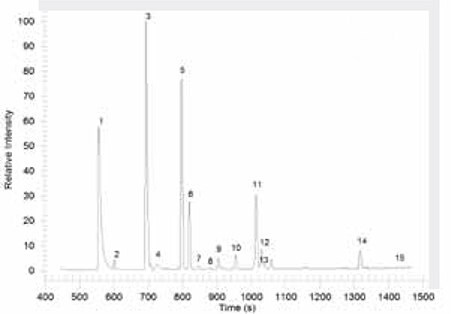Clinical Application of SPME: Analysis of VOCs in Exhaled Breath as Cancer Biomarkers
Bogusław Buszewski, Tomasz Ligor, Joanna Rudnicka
Department of Environmental Chemistry and Bioanalytics, Faculty of Chemistry Nicolaus Copernicus University, Gagarina 7 St., PL-87-100 Toruń, Polandk
Reporter US Volume 30.3
Introduction
Characteristic odors in breath have long been used as a tool for medical diagnosis. Familiar examples are diabetes with the odor of overripe apples, renal diseases with the fishy smell of amines and ammonia, and dental or liver diseases with the cabbage-like odor of organic sulfides1. Linus Pauling applied formal science to the analysis by using gas chromatography (GC) to detect volatile organic compounds (VOC) in breath2. More recently, Michael Philips and his Menssana coworkers focused on determination of breath compounds that are attracting attention in clinical and toxicological analysis3. Although breath analysis is of great importance in disease detection, toxicology, and the study of metabolic processes, its use by doctors and clinicians as a diagnostic tool is a lost art.
The classes of VOCs that can be present in exhaled breath include hydrocarbons, alcohols, ketones, aldehydes, esters, and organic sulfides4. The determination of VOCs in exhaled air requires the detection of very low concentrations. Hence, the analytical methods employed must include a preconcentration step. The common preconcentration methodologies currently utilized for VOCs are sorption onto an adsorbent and cold trapping.
However, solid phase microextraction (SPME) is a viable alternative to these methods, as will be shown here. SPME has been widely used for the determination of volatile organic compounds in various matrices, including exhaled breath5. Compared to other preconcentration techniques, SPME is simple, inexpensive, and solvent-free. It is fully automatable, and no thermal desorption unit or modifications to the GC instrument are necessary. Compatible with all GC systems, SPME can be used by practically every laboratory. The objective of this study was to use SPME with GC-MS analysis to identify volatile biomarkers of lung cancer.
Experimental
Breath samples were collected from ten healthy volunteers and twelve patients with lung cancer. Each participant provided via questionnaire their age, sex, other diseases, medications, smoking habits, and composition of recent meals. Breath samples were collected in 1 L Tedlar® bags which were kept at a constant 25 °C. A gas standard containing the compounds of interest was made by vaporizing a liquid mixture of the compounds in a glass bulb. A defined volume of the mixture was transferred into the Tedlar bag prior to sampling. During extraction, the CAR/PDMS SPME fiber was introduced into the bag containing breath sample or gas standards through a septum and exposed for 15 minutes. Ambient air samples were collected for background. External calibration was employed. The fiber desorption and sample analysis (GC-MS) conditions are shown in Figure 1.

Figure 1. GC-MS Analysis of VOC in Breath from Lung Cancer Patient after SPME Using CAR /PDMS Fibers SPME Conditions:sample: exhaled breath, 1 L in Tedlar bag; fiber: Carboxen®/Polydimethylsiloxane (CAR/PDMS), 75 µm film (57318); holder: manual SPME holder (57330-U); extraction: 15 min at 25 °C; desorption: 1 min at 220 °C
GC -MS Conditions: column conditions: GC PLOT column (Q-type), 25 m × 0.25 mm I.D., 3 µm; inj. temp.: 200 °C; oven: 40 °C (2 min), 10 °C/min to 140 °C, 5 °C/min to 270 °C (3 min); carrier gas: helium, 40 cm/sec, constant; injection: splitless 1 min, then split at 35:1; detector: MS, full scan, m/z 15-220, rate 3.46 scans/sec, EI ion source and transfer line temp: 220 °C
column: Ascentis® Express C18, 15 cm x 4.6 mm, 2.7 µm particles (53829-U); mobile phase: (A) 5:95 acetonitrile:water w/ 0.05% formic acid; (B) 95:5 acetonitrile:water w/ 0.05% formic acid; gradient: 40% to 70% B in 3 min; 70% to 90% B in 2 min; hold at 90% for 6 min, 90% to 40% in 0.1 min, hold at 40% for 3.9 min; flow rate: 1 mL/min; column temp.: 35 °C; detector: AB3200 QTrap MS, ESI(+), SIM; injection: 2 µL
Figure 1 shows a typical GC-MS chromatogram of breath from a lung cancer patient. Analysis of exhaled air from healthy volunteers and cancer patients identified seventeen volatile compounds, mainly hydrocarbons, ketones, aldehydes, and alcohols. Similar compounds were found in both healthy and cancer patients, except furan derivatives which are considered to be markers for tobacco smoking. Statistical tests were applied to distinguish cancer patients from the healthy control group. The VOC concentration data were log-transformed and tested for normality using the Shapiro-Wilks W test, (p<0.05). Full details of the statistical analysis is beyond the scope of this brief report; however, they are available upon request.
Summarizing: Although there was variation between the patients and not all patients exhibited the same biomarker pattern, four compounds stood out statistically from the others: methyl vinyl ketone, 1-propanol, 2-propanol, and o-xylene. These compounds showed statistically higher levels in cancer patients compared to the healthy control group.
Results
The linearity, precision, and detection limits for VOCs determination in human breath are presented in Table 1. The relative standard deviation (RSD) was in the range of 3.4% to 9.4%. Linear regression coefficient values (r²) were close to 1. The lowest LOD values obtained for hydrocarbons varied from 0.3 to 0.49 ppb.
Conclusion
This brief report is intended to demonstrate the potential of solid phase microextraction (SPME) as a clinical research tool, in this case toward the extraction from human breath of VOCs associated with lung cancer. By using SPME with GC-MS analysis and applying rigorous statistical methods, we found the VOC profiles between a small set of healthy individuals and those diagnosed with lung cancer were significantly different. These promising findings would necessarily be followed up with studies on larger populations for definitive associations. The SPME-GC-MS method presented here had the requisite linearity and sensitivity, and could be easily adopted by laboratories as an investigational tool into biomarker discovery, among many other applications relevant to the clinical and biochemical fields.
Acknowledgement
This research work was supported by Grant N N 204 026238 (2010-2013).
References
如要继续阅读,请登录或创建帐户。
暂无帐户?